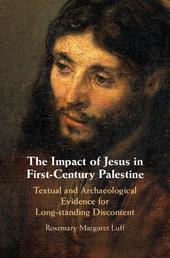
|
The Impact of Jesus in First-Century Palestine: Textual and Archaeological Evidence for Long-standing Discontent
Hardback
Main Details
| Title |
The Impact of Jesus in First-Century Palestine: Textual and Archaeological Evidence for Long-standing Discontent
|
| Authors and Contributors |
By (author) Rosemary Margaret Luff
|
| Physical Properties |
| Format:Hardback | | Pages:254 | | Dimensions(mm): Height 235,Width 157 |
|
| Category/Genre | History
Religion and beliefs
Religion - general
History of religion
Christianity
Judaism |
|---|
| ISBN/Barcode |
9781108482233
|
| Classifications | Dewey:232.9 |
|---|
| Audience | | Professional & Vocational | |
|---|
| Illustrations |
Worked examples or Exercises; 1 Tables, black and white; 3 Maps; 7 Halftones, black and white; 3 Line drawings, black and white
|
|
Publishing Details |
| Publisher |
Cambridge University Press
|
| Imprint |
Cambridge University Press
|
| Publication Date |
15 August 2019 |
| Publication Country |
United Kingdom
|
Description
Although the archaeological evidence indicates a prosperous and thriving Galilee in the early first century CE, the Gospel texts suggest a society under stress, where the rich were flourishing at the expense of the poor. In this multi-disciplinary study, Rosemary Margaret Luff contributes to current debates concerning the pressures on early first-century Palestinian Jews, particularly with reference to socio-economic and religious issues. She examines Jesus within his Jewish environment in order to understand why he rose to prominence when he did, and what motivated him to persevere with his mission. Luff's study includes six carefully-constructed essays that examine Early Christian texts against the wider background of late Second Temple Judaic literature, together with the material evidence of Galilee and Judea (Jerusalem). Synthesizing a wide range of archaeological and textual data for the first time, she offers new insights into the depth of social discontent and its role in the rise of Christianity.
Author Biography
Rosemary Margaret Luff is an archaeologist and an Emeritus Fellow at Clare Hall, University of Cambridge. During the 80s and early 90s, she ran a research unit in the Department of Archaeology specializing in the recovery and analysis of animal and human remains from a variety of prehistoric, Roman and medieval sites in Eastern England; the bones provided information on diet, disease, animal husbandry, socio-economics, mortality and religious practice. She later worked on excavations in Egypt, in particular those of the eighteenth Dynasty and Late Antique period, and subsequently directed a project (funded by the Leverhulme Trust) investigating the importance of aquatic versus terrestrial resources in the Pharaonic and Roman periods. While in Egypt she developed a keen interest in early monastic sites, and this resulted in her examining material in Israel, which ultimately led to the present project.
Reviews'The book is especially helpful in recording archaeological evidence that counters reconstructions of Jesus's Galilee based on sociological modeling.' A.-J. Levine, Choice '... it is by far the best study of what bones and other archaeological evidence for human and animal disease can tell us about the early 1st-century context of the Gospels yet published. The book deserves to be widely read by archaeologists, ancient historians and religious studies scholars for this alone, let alone its other contributions. However, the principal feature of the volume is that it contributes to situating the study of the early 1st-century 'Holy Land' firmly within the mainstream archaeology of the Roman provinces.' Ken Dark, Journal of Anglo-Israel Archaeological Society
|